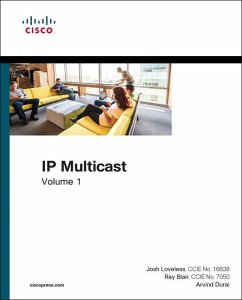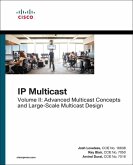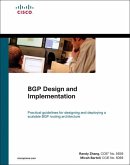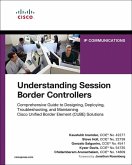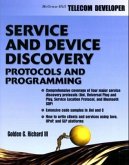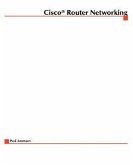- Broschiertes Buch
- Merkliste
- Auf die Merkliste
- Bewerten Bewerten
- Teilen
- Produkt teilen
- Produkterinnerung
- Produkterinnerung
IP Multicast, Volume I: Cisco IP Multicast Networking thoroughly covers basic IP multicast principles and routing techniques specific to modern Cisco routing and switching environments. Thorough and fully up to date, it offers pragmatic discussions of common features, design approaches, deployment models, and field practices for any contemporary IP multicast network and application. It also presents specific commands and start-to-finish methodologies for implementing and troubleshooting a wide spectrum of Cisco IP multicast networks. Coverage includes: * Core IP multicast concepts and…mehr
Andere Kunden interessierten sich auch für
![IP Multicast IP Multicast]() Josh LovelessIP Multicast66,99 €
Josh LovelessIP Multicast66,99 €![Cisco TCP/IP Routing Professional Reference Cisco TCP/IP Routing Professional Reference]() Cisco TCP/IP Routing Professional Reference59,99 €
Cisco TCP/IP Routing Professional Reference59,99 €![Bgp Design and Implementation Bgp Design and Implementation]() Randy ZhangBgp Design and Implementation71,99 €
Randy ZhangBgp Design and Implementation71,99 €![Understanding Session Border Controllers Understanding Session Border Controllers]() Kaustubh InamdarUnderstanding Session Border Controllers58,99 €
Kaustubh InamdarUnderstanding Session Border Controllers58,99 €![CGI Manual of Style CGI Manual of Style]() ShevchikCGI Manual of Style19,99 €
ShevchikCGI Manual of Style19,99 €![Service and Device Discovery Service and Device Discovery]() Golden G. RichardService and Device Discovery45,99 €
Golden G. RichardService and Device Discovery45,99 €![Cisco Router Internetworking Cisco Router Internetworking]() Cisco Router Internetworking57,99 €
Cisco Router Internetworking57,99 €-
-
-
IP Multicast, Volume I: Cisco IP Multicast Networking thoroughly covers basic IP multicast principles and routing techniques specific to modern Cisco routing and switching environments. Thorough and fully up to date, it offers pragmatic discussions of common features, design approaches, deployment models, and field practices for any contemporary IP multicast network and application. It also presents specific commands and start-to-finish methodologies for implementing and troubleshooting a wide spectrum of Cisco IP multicast networks. Coverage includes: * Core IP multicast concepts and applications as applied in modern Cisco networks * Network access and Layer 2 multicast (including layered encapsulation, IGMP group management, switching multicast frames, and more) * Layer 3 multicast concepts, including hosts and Protocol Independent Multicast (PIM) modes * PIM in depth: basic forwarding trees, Rendezvous Point (RP) mechanics, propagation of RP mapping information, and widely-used forwarding modes * IP multicast design considerations and implementation: scoping multicast enterprise networks, forwarding replication, MFIB/MRIB, and more * Best practices for improving IP multicast security and resiliency * IPv6 multicast networks: Layer 2 and Layer 3 * Implementation differences in NX-OS, IOS, and IOS-XE * Multicast network operation and troubleshooting, including tools and methodologies
Hinweis: Dieser Artikel kann nur an eine deutsche Lieferadresse ausgeliefert werden.
Hinweis: Dieser Artikel kann nur an eine deutsche Lieferadresse ausgeliefert werden.
Produktdetails
- Produktdetails
- Verlag: Pearson Education
- Seitenzahl: 384
- Erscheinungstermin: 12. Oktober 2016
- Englisch
- Abmessung: 231mm x 187mm x 25mm
- Gewicht: 644g
- ISBN-13: 9781587144592
- ISBN-10: 158714459X
- Artikelnr.: 44496334
- Herstellerkennzeichnung
- Libri GmbH
- Europaallee 1
- 36244 Bad Hersfeld
- gpsr@libri.de
- Verlag: Pearson Education
- Seitenzahl: 384
- Erscheinungstermin: 12. Oktober 2016
- Englisch
- Abmessung: 231mm x 187mm x 25mm
- Gewicht: 644g
- ISBN-13: 9781587144592
- ISBN-10: 158714459X
- Artikelnr.: 44496334
- Herstellerkennzeichnung
- Libri GmbH
- Europaallee 1
- 36244 Bad Hersfeld
- gpsr@libri.de
Josh Loveless, CCIE No. 16638, is a customer solutions architect for Cisco Systems. He has been with Cisco for four years, providing architecture and support services for Tier 1 service providers as well as for many of Cisco’s largest enterprise customers, specializing in large-scale routing and switching designs. Currently, Josh is helping Cisco’s customers in the defense and intelligence industries meet the challenges of an ever-changing technology landscape, designing secure automated networks with advanced capabilities, including IP multicast. Prior to joining Cisco, he spent 15 years working for large service providers and enterprises as both an engineer and an architect, as well as providing training and architecture services to some of Cisco’s trusted partners. Josh maintains two CCIE certifications, Routing and Switching and Service Provider. Ray Blair, CCIE No. 7050, is a distinguished systems engineer and has been with Cisco Systems since 1999. He uses his years of experience to align technology solutions with business needs, insuring customer success. Ray started his career in 1988, designing industrial monitoring and communication systems. Since that time, he has been involved with server/database administration and the design, implementation, and management of networks that included networking technologies from ATM to ZMODEM. He maintains three CCIE certifications in Routing and Switching, Security, and Service Provider (No. 7050), is also a Certified Information Systems Security Professional (CISSP), and a Certified Business Architect (No. 00298). Ray is coauthor of two Cisco Press books, Cisco Secure Firewall Services Module and Tcl Scripting for Cisco IOS. He speaks at many industry events and is a Cisco Live distinguished speaker. Arvind Durai, CCIE No. 7016, is a director of solution integration for Cisco Advanced Services. His primary responsibility in the past 17 years has been in supporting major Cisco customers in the enterprise sector, including financial, retail, manufacturing, ecommerce, state government, utility (smart grid networks), and healthcare sectors. Some of his focuses have been on security, multicast, network virtualization, and data center, and he has authored several white papers and design guides on various technologies. He has been involved in multicast designs for several enterprise customers in different verticals. He is also one of the contributors in providing the framework for Advanced Services Multicast Audit tool that helps customers assess their operational multicast network to Industry best practices. Arvind maintains two CCIE certifications: Routing and Switching and Security and also is a Certified Business Architect. He holds a Bachelor of Science degree in Electronics and Communication, a Master’s degree in Electrical Engineering (MS), and a Master’s degree in Business Administration (MBA). He is a coauthor of three Cisco Press books: Cisco Secure Firewall Services Module, Virtual Routing in the Cloud, and TcL Scripting for Cisco IOS. He has coauthored IEEE WAN smart grid architecture and presented in many industry forums, such as IEEE and Cisco Live.
Introduction xv
Chapter 1 Introduction to IP Multicast 1
What Problem Does Multicast Solve? 3
Multicast Applications and Services 5
One-to-Many Multicast Applications 5
Many-to-Many Multicast Applications 6
Many-to-One Multicast Applications 7
Multicast Packet 8
What Is a Source? 9
What Is a Receiver? 10
L3 Multicast Is Built on the TCP/IP Protocol Stack 10
It’s a Group Thing 11
IPv4 Layer 3 Multicast Addressing Defines Groups 13
IPv4 Multicast Group Address Assignments 14
Important Multicast Groups and Group Considerations 16
IPv4 Local Network Control 16
IPv4 Inter-Network Control 18
The History of Multicast 19
The MBone 20
Native Internet Multicast 20
IPv6 Multicast 20
Multicast Development and Standardization 21
Summary 21
Chapter 2 Network Access and Layer 2 Multicast 23
Layered Encapsulation 23
MAC Address Mapping 26
Switching Multicast Frames 28
Group Subscription 29
IGMP on the Gateway Router 30
IGMP Versions 31
IGMPv1 31
IGMPv2 32
IGMPv3 35
Configuring IGMP on a Router 37
Mixed Groups: Interoperability Between IGMPv1, v2, and v3 38
Layer 2 Group Management 38
Cisco Group Management Protocol 38
The CGMP Leave Process 39
Router-Port Group Management Protocol 39
Snooping 40
IGMP Snooping 40
Maintaining Group Membership 44
Configuring IP IGMP Snooping 44
The Process of Packet Replication in a Switch 45
Protecting Layer 2 47
Storm Control 47
Summary 49
References 49
Chapter 3 IP Multicast at Layer 3 51
Multicast Hosts 52
Networked Groups: Client/Server 52
Network Hosts 53
Multicast Routing: An Introduction to Protocol Independent Multicast and
Multicast Trees 54
Seeing the Forest Through the Trees 55
What Is a Network Tree? 55
Concepts of PIM Group States 57
The (*,G) State Entry 58
The (S,G) State Entry 60
Reverse Path Forwarding 61
Two Types of Trees 63
Source Trees (Shortest Path Trees) 64
Shared Trees 66
Branches on a Tree 68
PIM Neighbors 68
Designated Routers 69
PIM Messages: Join, Leave, Prune, Graft, and Assert 72
Join 75
Leave and Prune 75
Graft 75
Assert 75
PIM Modes 76
PIM Dense-Mode 76
PIM Sparse-Mode 77
PIM Sparse-Dense Mode 80
Multicast Flow at the Leaf 81
Leaving an IGMP Group 85
The Rendezvous Point and Shared Tree Dynamics 87
From a Shared Tree to a Source Tree 94
Building the Multicast Routing Information Base 101
Multicast Routing Information Base and Multicast Forwarding Information
Base 102
PIM-BiDir 104
PIM-SSM 110
Summary 119
Chapter 4 Protocol Independent Multicast 121
RP Overview 121
IP Multicast Domains 124
Basic PIM Configuration 128
Static RP 129
PIM Dense Mode 132
Dynamic RP Information Propagation 134
Auto RP 135
Sample Configuration: Auto-RP for IOS 137
Sample Configuration: Auto-RP for IOS-XR 139
Sample Configuration: Auto-RP for NX-OS 141
BSR 143
Sample Configuration: BSR in IOS 145
Sample Configuration: BSR in IOS-XR 146
Sample Configuration: BSR in NX-OS 148
Anycast RP 149
Multicast Source Discovery Protocol 150
PIM Anycast RP 151
Sample Configuration: Anycast RP with MSDP on IOS 153
Sample Configuration: Anycast with MSDP on IOS-XR 155
Sample Configuration: Anycast on NX-OS 158
Phantom RP 160
Sample Configuration–Phantom RP on IOS 161
PIM SSM Configuration 162
Summary 164
Chapter 5 IP Multicast Design Considerations and Implementation 167
Multicast Group Scoping 167
Organizational and Global Group Assignment Considerations 168
IPv4 Considerations 170
Using Group Scoping for Hybrid Designs and RP Placement 173
Multicast RP Design with MSDP Mesh Group 178
Multicast RP Hybrid Design with Scoped Multicast Domains 181
RP Placement 186
Multicast Traffic Engineering and Forwarding 186
More on mRIB, mFIB, and RPF Checks 188
Traffic Engineering Using IP Multipath Feature 197
Multicast Traffic Engineering: Deterministic Path Selection 201
IP Multicast Best Practices and Security 209
Before Enabling PIM 209
General Best Practices 210
Tuning the Network for Multicast 211
Manually Selecting Designated Routers 212
Basic Multicast Security 216
Protecting Multicast Control-plane and Data-plane Resources 216
Securing Multicast Domains with Boundaries and Borders 218
Protecting Multicast RPs 225
Best Practice and Security Summary 226
Putting It All Together 228
Scenario: Multicaster’s Bank Corp. Media Services 228
Summary 238
Chapter 6 IPv6 Multicast Networks 239
IPv6 Fundamentals: A Quick Overview 239
IPv6 Layer 3 Multicast Group Addressing 242
IPv6 Multicast Group Address Assignments 245
IANA Unicast-Prefix—Based Multicast Address 247
IPv6 Source-Specific Addressing 248
Solicited-Node Multicast Addresses 249
IPv6 Address Scoping and Schema Considerations 249
Multicast-IPv6-Address-to-MAC-Address Mapping 250
IPv6 Layer 2 and Layer 3 Multicast 250
Multicast Listener Discovery for IPv6 251
MLDv1 251
MLDv2 253
Configuring MLD and the MLD Message Process 253
Multicast Listener Discovery Joining a Group and Forwarding Traffic 255
Leaving a MLD Group 258
Multicast Listener Discovery (MLD) Snooping 258
Configuring MLD Snooping 259
IPv6 Layer 3 Multicast and Protocol Independent Multicast 6 (PIM6) 261
PIM6 Static mroute Entries 268
PIM6 Group Modes 269
Summary 282
Chapter 7 Operating and Troubleshooting IP Multicast Networks 283
Multicast Troubleshooting Logic 283
Multicast Troubleshooting Methodology 283
Baseline Check: Source and Receiver Verification 287
State Verification 293
RP Control-Plane Check 294
Hop-by-Hop State Validation 299
Overview of Common Tools for Multicast Troubleshooting 303
Ping Test 303
SLA Test 304
Common Multicast Debug Commands 307
debug ip mpacket Command 307
debug ip pim Command 307
debug ip igmp Command 308
Multicast Troubleshooting 309
Multicast Troubleshooting Case Study 310
Baseline Check: Source and Receiver Verification 312
Important Multicast show Commands 326
show ip igmp group Command 326
show ip igmp interface/show igmp interface Commands 326
show ip mroute/show mrib route Command 328
show ip pim interface/show pim interface Commands 330
show ip pim neighbor/show pim neighbor Commands 330
show ip pim rp Command 331
show ip pim rp mapping/show pim rp mapping Commands 332
Summary 333
9781587144592 TOC 9/8/2016
Chapter 1 Introduction to IP Multicast 1
What Problem Does Multicast Solve? 3
Multicast Applications and Services 5
One-to-Many Multicast Applications 5
Many-to-Many Multicast Applications 6
Many-to-One Multicast Applications 7
Multicast Packet 8
What Is a Source? 9
What Is a Receiver? 10
L3 Multicast Is Built on the TCP/IP Protocol Stack 10
It’s a Group Thing 11
IPv4 Layer 3 Multicast Addressing Defines Groups 13
IPv4 Multicast Group Address Assignments 14
Important Multicast Groups and Group Considerations 16
IPv4 Local Network Control 16
IPv4 Inter-Network Control 18
The History of Multicast 19
The MBone 20
Native Internet Multicast 20
IPv6 Multicast 20
Multicast Development and Standardization 21
Summary 21
Chapter 2 Network Access and Layer 2 Multicast 23
Layered Encapsulation 23
MAC Address Mapping 26
Switching Multicast Frames 28
Group Subscription 29
IGMP on the Gateway Router 30
IGMP Versions 31
IGMPv1 31
IGMPv2 32
IGMPv3 35
Configuring IGMP on a Router 37
Mixed Groups: Interoperability Between IGMPv1, v2, and v3 38
Layer 2 Group Management 38
Cisco Group Management Protocol 38
The CGMP Leave Process 39
Router-Port Group Management Protocol 39
Snooping 40
IGMP Snooping 40
Maintaining Group Membership 44
Configuring IP IGMP Snooping 44
The Process of Packet Replication in a Switch 45
Protecting Layer 2 47
Storm Control 47
Summary 49
References 49
Chapter 3 IP Multicast at Layer 3 51
Multicast Hosts 52
Networked Groups: Client/Server 52
Network Hosts 53
Multicast Routing: An Introduction to Protocol Independent Multicast and
Multicast Trees 54
Seeing the Forest Through the Trees 55
What Is a Network Tree? 55
Concepts of PIM Group States 57
The (*,G) State Entry 58
The (S,G) State Entry 60
Reverse Path Forwarding 61
Two Types of Trees 63
Source Trees (Shortest Path Trees) 64
Shared Trees 66
Branches on a Tree 68
PIM Neighbors 68
Designated Routers 69
PIM Messages: Join, Leave, Prune, Graft, and Assert 72
Join 75
Leave and Prune 75
Graft 75
Assert 75
PIM Modes 76
PIM Dense-Mode 76
PIM Sparse-Mode 77
PIM Sparse-Dense Mode 80
Multicast Flow at the Leaf 81
Leaving an IGMP Group 85
The Rendezvous Point and Shared Tree Dynamics 87
From a Shared Tree to a Source Tree 94
Building the Multicast Routing Information Base 101
Multicast Routing Information Base and Multicast Forwarding Information
Base 102
PIM-BiDir 104
PIM-SSM 110
Summary 119
Chapter 4 Protocol Independent Multicast 121
RP Overview 121
IP Multicast Domains 124
Basic PIM Configuration 128
Static RP 129
PIM Dense Mode 132
Dynamic RP Information Propagation 134
Auto RP 135
Sample Configuration: Auto-RP for IOS 137
Sample Configuration: Auto-RP for IOS-XR 139
Sample Configuration: Auto-RP for NX-OS 141
BSR 143
Sample Configuration: BSR in IOS 145
Sample Configuration: BSR in IOS-XR 146
Sample Configuration: BSR in NX-OS 148
Anycast RP 149
Multicast Source Discovery Protocol 150
PIM Anycast RP 151
Sample Configuration: Anycast RP with MSDP on IOS 153
Sample Configuration: Anycast with MSDP on IOS-XR 155
Sample Configuration: Anycast on NX-OS 158
Phantom RP 160
Sample Configuration–Phantom RP on IOS 161
PIM SSM Configuration 162
Summary 164
Chapter 5 IP Multicast Design Considerations and Implementation 167
Multicast Group Scoping 167
Organizational and Global Group Assignment Considerations 168
IPv4 Considerations 170
Using Group Scoping for Hybrid Designs and RP Placement 173
Multicast RP Design with MSDP Mesh Group 178
Multicast RP Hybrid Design with Scoped Multicast Domains 181
RP Placement 186
Multicast Traffic Engineering and Forwarding 186
More on mRIB, mFIB, and RPF Checks 188
Traffic Engineering Using IP Multipath Feature 197
Multicast Traffic Engineering: Deterministic Path Selection 201
IP Multicast Best Practices and Security 209
Before Enabling PIM 209
General Best Practices 210
Tuning the Network for Multicast 211
Manually Selecting Designated Routers 212
Basic Multicast Security 216
Protecting Multicast Control-plane and Data-plane Resources 216
Securing Multicast Domains with Boundaries and Borders 218
Protecting Multicast RPs 225
Best Practice and Security Summary 226
Putting It All Together 228
Scenario: Multicaster’s Bank Corp. Media Services 228
Summary 238
Chapter 6 IPv6 Multicast Networks 239
IPv6 Fundamentals: A Quick Overview 239
IPv6 Layer 3 Multicast Group Addressing 242
IPv6 Multicast Group Address Assignments 245
IANA Unicast-Prefix—Based Multicast Address 247
IPv6 Source-Specific Addressing 248
Solicited-Node Multicast Addresses 249
IPv6 Address Scoping and Schema Considerations 249
Multicast-IPv6-Address-to-MAC-Address Mapping 250
IPv6 Layer 2 and Layer 3 Multicast 250
Multicast Listener Discovery for IPv6 251
MLDv1 251
MLDv2 253
Configuring MLD and the MLD Message Process 253
Multicast Listener Discovery Joining a Group and Forwarding Traffic 255
Leaving a MLD Group 258
Multicast Listener Discovery (MLD) Snooping 258
Configuring MLD Snooping 259
IPv6 Layer 3 Multicast and Protocol Independent Multicast 6 (PIM6) 261
PIM6 Static mroute Entries 268
PIM6 Group Modes 269
Summary 282
Chapter 7 Operating and Troubleshooting IP Multicast Networks 283
Multicast Troubleshooting Logic 283
Multicast Troubleshooting Methodology 283
Baseline Check: Source and Receiver Verification 287
State Verification 293
RP Control-Plane Check 294
Hop-by-Hop State Validation 299
Overview of Common Tools for Multicast Troubleshooting 303
Ping Test 303
SLA Test 304
Common Multicast Debug Commands 307
debug ip mpacket Command 307
debug ip pim Command 307
debug ip igmp Command 308
Multicast Troubleshooting 309
Multicast Troubleshooting Case Study 310
Baseline Check: Source and Receiver Verification 312
Important Multicast show Commands 326
show ip igmp group Command 326
show ip igmp interface/show igmp interface Commands 326
show ip mroute/show mrib route Command 328
show ip pim interface/show pim interface Commands 330
show ip pim neighbor/show pim neighbor Commands 330
show ip pim rp Command 331
show ip pim rp mapping/show pim rp mapping Commands 332
Summary 333
9781587144592 TOC 9/8/2016
Introduction xv
Chapter 1 Introduction to IP Multicast 1
What Problem Does Multicast Solve? 3
Multicast Applications and Services 5
One-to-Many Multicast Applications 5
Many-to-Many Multicast Applications 6
Many-to-One Multicast Applications 7
Multicast Packet 8
What Is a Source? 9
What Is a Receiver? 10
L3 Multicast Is Built on the TCP/IP Protocol Stack 10
It’s a Group Thing 11
IPv4 Layer 3 Multicast Addressing Defines Groups 13
IPv4 Multicast Group Address Assignments 14
Important Multicast Groups and Group Considerations 16
IPv4 Local Network Control 16
IPv4 Inter-Network Control 18
The History of Multicast 19
The MBone 20
Native Internet Multicast 20
IPv6 Multicast 20
Multicast Development and Standardization 21
Summary 21
Chapter 2 Network Access and Layer 2 Multicast 23
Layered Encapsulation 23
MAC Address Mapping 26
Switching Multicast Frames 28
Group Subscription 29
IGMP on the Gateway Router 30
IGMP Versions 31
IGMPv1 31
IGMPv2 32
IGMPv3 35
Configuring IGMP on a Router 37
Mixed Groups: Interoperability Between IGMPv1, v2, and v3 38
Layer 2 Group Management 38
Cisco Group Management Protocol 38
The CGMP Leave Process 39
Router-Port Group Management Protocol 39
Snooping 40
IGMP Snooping 40
Maintaining Group Membership 44
Configuring IP IGMP Snooping 44
The Process of Packet Replication in a Switch 45
Protecting Layer 2 47
Storm Control 47
Summary 49
References 49
Chapter 3 IP Multicast at Layer 3 51
Multicast Hosts 52
Networked Groups: Client/Server 52
Network Hosts 53
Multicast Routing: An Introduction to Protocol Independent Multicast and
Multicast Trees 54
Seeing the Forest Through the Trees 55
What Is a Network Tree? 55
Concepts of PIM Group States 57
The (*,G) State Entry 58
The (S,G) State Entry 60
Reverse Path Forwarding 61
Two Types of Trees 63
Source Trees (Shortest Path Trees) 64
Shared Trees 66
Branches on a Tree 68
PIM Neighbors 68
Designated Routers 69
PIM Messages: Join, Leave, Prune, Graft, and Assert 72
Join 75
Leave and Prune 75
Graft 75
Assert 75
PIM Modes 76
PIM Dense-Mode 76
PIM Sparse-Mode 77
PIM Sparse-Dense Mode 80
Multicast Flow at the Leaf 81
Leaving an IGMP Group 85
The Rendezvous Point and Shared Tree Dynamics 87
From a Shared Tree to a Source Tree 94
Building the Multicast Routing Information Base 101
Multicast Routing Information Base and Multicast Forwarding Information
Base 102
PIM-BiDir 104
PIM-SSM 110
Summary 119
Chapter 4 Protocol Independent Multicast 121
RP Overview 121
IP Multicast Domains 124
Basic PIM Configuration 128
Static RP 129
PIM Dense Mode 132
Dynamic RP Information Propagation 134
Auto RP 135
Sample Configuration: Auto-RP for IOS 137
Sample Configuration: Auto-RP for IOS-XR 139
Sample Configuration: Auto-RP for NX-OS 141
BSR 143
Sample Configuration: BSR in IOS 145
Sample Configuration: BSR in IOS-XR 146
Sample Configuration: BSR in NX-OS 148
Anycast RP 149
Multicast Source Discovery Protocol 150
PIM Anycast RP 151
Sample Configuration: Anycast RP with MSDP on IOS 153
Sample Configuration: Anycast with MSDP on IOS-XR 155
Sample Configuration: Anycast on NX-OS 158
Phantom RP 160
Sample Configuration–Phantom RP on IOS 161
PIM SSM Configuration 162
Summary 164
Chapter 5 IP Multicast Design Considerations and Implementation 167
Multicast Group Scoping 167
Organizational and Global Group Assignment Considerations 168
IPv4 Considerations 170
Using Group Scoping for Hybrid Designs and RP Placement 173
Multicast RP Design with MSDP Mesh Group 178
Multicast RP Hybrid Design with Scoped Multicast Domains 181
RP Placement 186
Multicast Traffic Engineering and Forwarding 186
More on mRIB, mFIB, and RPF Checks 188
Traffic Engineering Using IP Multipath Feature 197
Multicast Traffic Engineering: Deterministic Path Selection 201
IP Multicast Best Practices and Security 209
Before Enabling PIM 209
General Best Practices 210
Tuning the Network for Multicast 211
Manually Selecting Designated Routers 212
Basic Multicast Security 216
Protecting Multicast Control-plane and Data-plane Resources 216
Securing Multicast Domains with Boundaries and Borders 218
Protecting Multicast RPs 225
Best Practice and Security Summary 226
Putting It All Together 228
Scenario: Multicaster’s Bank Corp. Media Services 228
Summary 238
Chapter 6 IPv6 Multicast Networks 239
IPv6 Fundamentals: A Quick Overview 239
IPv6 Layer 3 Multicast Group Addressing 242
IPv6 Multicast Group Address Assignments 245
IANA Unicast-Prefix—Based Multicast Address 247
IPv6 Source-Specific Addressing 248
Solicited-Node Multicast Addresses 249
IPv6 Address Scoping and Schema Considerations 249
Multicast-IPv6-Address-to-MAC-Address Mapping 250
IPv6 Layer 2 and Layer 3 Multicast 250
Multicast Listener Discovery for IPv6 251
MLDv1 251
MLDv2 253
Configuring MLD and the MLD Message Process 253
Multicast Listener Discovery Joining a Group and Forwarding Traffic 255
Leaving a MLD Group 258
Multicast Listener Discovery (MLD) Snooping 258
Configuring MLD Snooping 259
IPv6 Layer 3 Multicast and Protocol Independent Multicast 6 (PIM6) 261
PIM6 Static mroute Entries 268
PIM6 Group Modes 269
Summary 282
Chapter 7 Operating and Troubleshooting IP Multicast Networks 283
Multicast Troubleshooting Logic 283
Multicast Troubleshooting Methodology 283
Baseline Check: Source and Receiver Verification 287
State Verification 293
RP Control-Plane Check 294
Hop-by-Hop State Validation 299
Overview of Common Tools for Multicast Troubleshooting 303
Ping Test 303
SLA Test 304
Common Multicast Debug Commands 307
debug ip mpacket Command 307
debug ip pim Command 307
debug ip igmp Command 308
Multicast Troubleshooting 309
Multicast Troubleshooting Case Study 310
Baseline Check: Source and Receiver Verification 312
Important Multicast show Commands 326
show ip igmp group Command 326
show ip igmp interface/show igmp interface Commands 326
show ip mroute/show mrib route Command 328
show ip pim interface/show pim interface Commands 330
show ip pim neighbor/show pim neighbor Commands 330
show ip pim rp Command 331
show ip pim rp mapping/show pim rp mapping Commands 332
Summary 333
9781587144592 TOC 9/8/2016
Chapter 1 Introduction to IP Multicast 1
What Problem Does Multicast Solve? 3
Multicast Applications and Services 5
One-to-Many Multicast Applications 5
Many-to-Many Multicast Applications 6
Many-to-One Multicast Applications 7
Multicast Packet 8
What Is a Source? 9
What Is a Receiver? 10
L3 Multicast Is Built on the TCP/IP Protocol Stack 10
It’s a Group Thing 11
IPv4 Layer 3 Multicast Addressing Defines Groups 13
IPv4 Multicast Group Address Assignments 14
Important Multicast Groups and Group Considerations 16
IPv4 Local Network Control 16
IPv4 Inter-Network Control 18
The History of Multicast 19
The MBone 20
Native Internet Multicast 20
IPv6 Multicast 20
Multicast Development and Standardization 21
Summary 21
Chapter 2 Network Access and Layer 2 Multicast 23
Layered Encapsulation 23
MAC Address Mapping 26
Switching Multicast Frames 28
Group Subscription 29
IGMP on the Gateway Router 30
IGMP Versions 31
IGMPv1 31
IGMPv2 32
IGMPv3 35
Configuring IGMP on a Router 37
Mixed Groups: Interoperability Between IGMPv1, v2, and v3 38
Layer 2 Group Management 38
Cisco Group Management Protocol 38
The CGMP Leave Process 39
Router-Port Group Management Protocol 39
Snooping 40
IGMP Snooping 40
Maintaining Group Membership 44
Configuring IP IGMP Snooping 44
The Process of Packet Replication in a Switch 45
Protecting Layer 2 47
Storm Control 47
Summary 49
References 49
Chapter 3 IP Multicast at Layer 3 51
Multicast Hosts 52
Networked Groups: Client/Server 52
Network Hosts 53
Multicast Routing: An Introduction to Protocol Independent Multicast and
Multicast Trees 54
Seeing the Forest Through the Trees 55
What Is a Network Tree? 55
Concepts of PIM Group States 57
The (*,G) State Entry 58
The (S,G) State Entry 60
Reverse Path Forwarding 61
Two Types of Trees 63
Source Trees (Shortest Path Trees) 64
Shared Trees 66
Branches on a Tree 68
PIM Neighbors 68
Designated Routers 69
PIM Messages: Join, Leave, Prune, Graft, and Assert 72
Join 75
Leave and Prune 75
Graft 75
Assert 75
PIM Modes 76
PIM Dense-Mode 76
PIM Sparse-Mode 77
PIM Sparse-Dense Mode 80
Multicast Flow at the Leaf 81
Leaving an IGMP Group 85
The Rendezvous Point and Shared Tree Dynamics 87
From a Shared Tree to a Source Tree 94
Building the Multicast Routing Information Base 101
Multicast Routing Information Base and Multicast Forwarding Information
Base 102
PIM-BiDir 104
PIM-SSM 110
Summary 119
Chapter 4 Protocol Independent Multicast 121
RP Overview 121
IP Multicast Domains 124
Basic PIM Configuration 128
Static RP 129
PIM Dense Mode 132
Dynamic RP Information Propagation 134
Auto RP 135
Sample Configuration: Auto-RP for IOS 137
Sample Configuration: Auto-RP for IOS-XR 139
Sample Configuration: Auto-RP for NX-OS 141
BSR 143
Sample Configuration: BSR in IOS 145
Sample Configuration: BSR in IOS-XR 146
Sample Configuration: BSR in NX-OS 148
Anycast RP 149
Multicast Source Discovery Protocol 150
PIM Anycast RP 151
Sample Configuration: Anycast RP with MSDP on IOS 153
Sample Configuration: Anycast with MSDP on IOS-XR 155
Sample Configuration: Anycast on NX-OS 158
Phantom RP 160
Sample Configuration–Phantom RP on IOS 161
PIM SSM Configuration 162
Summary 164
Chapter 5 IP Multicast Design Considerations and Implementation 167
Multicast Group Scoping 167
Organizational and Global Group Assignment Considerations 168
IPv4 Considerations 170
Using Group Scoping for Hybrid Designs and RP Placement 173
Multicast RP Design with MSDP Mesh Group 178
Multicast RP Hybrid Design with Scoped Multicast Domains 181
RP Placement 186
Multicast Traffic Engineering and Forwarding 186
More on mRIB, mFIB, and RPF Checks 188
Traffic Engineering Using IP Multipath Feature 197
Multicast Traffic Engineering: Deterministic Path Selection 201
IP Multicast Best Practices and Security 209
Before Enabling PIM 209
General Best Practices 210
Tuning the Network for Multicast 211
Manually Selecting Designated Routers 212
Basic Multicast Security 216
Protecting Multicast Control-plane and Data-plane Resources 216
Securing Multicast Domains with Boundaries and Borders 218
Protecting Multicast RPs 225
Best Practice and Security Summary 226
Putting It All Together 228
Scenario: Multicaster’s Bank Corp. Media Services 228
Summary 238
Chapter 6 IPv6 Multicast Networks 239
IPv6 Fundamentals: A Quick Overview 239
IPv6 Layer 3 Multicast Group Addressing 242
IPv6 Multicast Group Address Assignments 245
IANA Unicast-Prefix—Based Multicast Address 247
IPv6 Source-Specific Addressing 248
Solicited-Node Multicast Addresses 249
IPv6 Address Scoping and Schema Considerations 249
Multicast-IPv6-Address-to-MAC-Address Mapping 250
IPv6 Layer 2 and Layer 3 Multicast 250
Multicast Listener Discovery for IPv6 251
MLDv1 251
MLDv2 253
Configuring MLD and the MLD Message Process 253
Multicast Listener Discovery Joining a Group and Forwarding Traffic 255
Leaving a MLD Group 258
Multicast Listener Discovery (MLD) Snooping 258
Configuring MLD Snooping 259
IPv6 Layer 3 Multicast and Protocol Independent Multicast 6 (PIM6) 261
PIM6 Static mroute Entries 268
PIM6 Group Modes 269
Summary 282
Chapter 7 Operating and Troubleshooting IP Multicast Networks 283
Multicast Troubleshooting Logic 283
Multicast Troubleshooting Methodology 283
Baseline Check: Source and Receiver Verification 287
State Verification 293
RP Control-Plane Check 294
Hop-by-Hop State Validation 299
Overview of Common Tools for Multicast Troubleshooting 303
Ping Test 303
SLA Test 304
Common Multicast Debug Commands 307
debug ip mpacket Command 307
debug ip pim Command 307
debug ip igmp Command 308
Multicast Troubleshooting 309
Multicast Troubleshooting Case Study 310
Baseline Check: Source and Receiver Verification 312
Important Multicast show Commands 326
show ip igmp group Command 326
show ip igmp interface/show igmp interface Commands 326
show ip mroute/show mrib route Command 328
show ip pim interface/show pim interface Commands 330
show ip pim neighbor/show pim neighbor Commands 330
show ip pim rp Command 331
show ip pim rp mapping/show pim rp mapping Commands 332
Summary 333
9781587144592 TOC 9/8/2016

